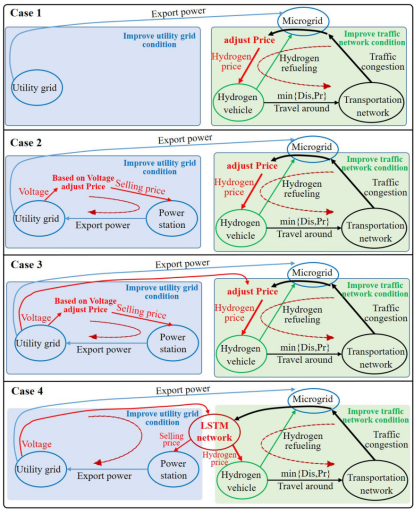近日��,深圳大學化學與環(huán)境工程學院李倍老師在領域頂級期刊IEEE Transactions on Intelligent Transportation Systems(影響因子7.9,中科院1區(qū)�����,TOP期刊)上發(fā)表了題為“Real-Time Hydrogen Refuelling of the Fuel Cell Electric Vehicle Through the Coupled Transportation Network and Power System”的研究論文��。李倍為獨立第一作者�����。深圳大學為第一單位�����。其他作者包括Jiangchen Li, Nanjing University of Aeronautics and Astronautics, China�����;Zhixiong Li, Opole University of Technology, Poland��;Miguel Angel Sotelo, University of Alcalá, Spain�����。

HFCEV的加氫仍然是一個亟待解決的問題。本文提出一種基于氫電微網(wǎng)來生產(chǎn)氫氣����,為HFCEV加氫,并提出了不同的策略來引導HFCEV在交通網(wǎng)絡與電力系統(tǒng)耦合下的加氫行為���。首先�,根據(jù)實際交通網(wǎng)絡構建HFCEV交通流模型��。其次����,建立實時仿真算法����。第三,構建基于氫氣的微電網(wǎng)為HFCEV加氫�。第四,建立IEEE 30節(jié)點電網(wǎng)輸出功率模型�����。最后�,提出通過交通網(wǎng)絡與電力網(wǎng)絡的耦合實現(xiàn)HFCEV實時加氫。耦合結構如圖1�����,并比較了不同的HFCEV加氫策略(固定價格、動態(tài)價格�、LSTM決策價格)。結果表明���,在動態(tài)價格下�,交通網(wǎng)絡的擁堵得到改善�����,等待時間減少了17.71%�����,網(wǎng)絡的時間損失減少了13.29%�����。通過合理的價格引導�,車輛會選擇指定的站點進行氫氣加注,并影響交通網(wǎng)絡車流量的時空分布�����。此外,通過調整發(fā)電站輸出功率和加氫站輸入功率����,可以改善電力系統(tǒng)的電壓條件。

圖1 電網(wǎng)-微網(wǎng)-交通網(wǎng)耦合結構
分析了四種不同的電網(wǎng)耦合交通網(wǎng)結構如下圖2所示:
1) In Case 1, the power station is not considered, only microgrids are considered;
2) In Case 2, the power station is considered, the exporting power of the power station is adjusted based on the selling price, and the selling price is adjusted based on the utility grid voltage; in addition, in microgrid, the hydrogen price is adjusted based on the traffic congestion;
3) In Case 3, the power station is considered, the difference is that in the microgrid, the hydrogen price is adjusted based on the utility grid voltage and the traffic congestion;
4) In Case 4, an LSTM network is adopted to train the relationship between states (voltage, traffic flow) and the price. The hydrogen price is decided based on the smart LSTM network.
此外�,在Case 1中3種不同的價格場景Case 1A, Case 1B, and Case 1C被進行比較,包括:
Case 1A:hydrogen price is not considered, and vehicles choose the nearest distance station to refuel hydrogen;
Case 1B:fixed hydrogen price is considered;
Case 1C:dynamic hydrogen price is considered, and the price is dynamically adjusted basedon the traffic congestion. Three different users choosing refuelling station strategies are compared.

圖2 電網(wǎng)耦合交通網(wǎng)的不同場景
結果:在不同場景下的交通網(wǎng)狀態(tài)如表1所示���;電網(wǎng)的電壓偏移情況如下圖所示����。



原文鏈接:https://ieeexplore-ieee-org-s.webvpn.szu.edu.cn/document/10557141
李倍曾于2015-2019年在法國國家科學研究中心(CNRS)Femto-st, FCLAB實驗室從事科學研究���。目前擔任深圳大學能源科學與工程系教師。至今以獨立第一作者發(fā)表SCI/EI英文論文30余篇�,獨立第一作者SCI期刊論文18篇,包括IEEE Transactions on Intelligent Transportation Systems, eTransportation, Applied energy等國際知名期刊���,其中包括一篇ESI高被引論文���。





